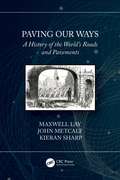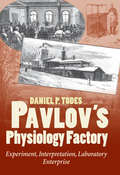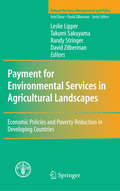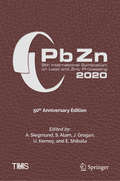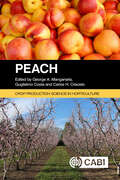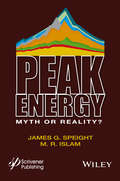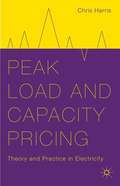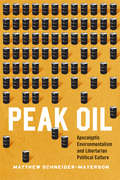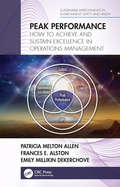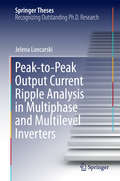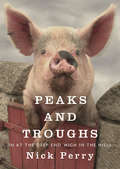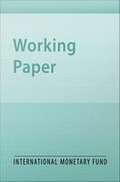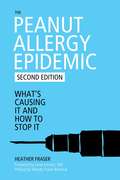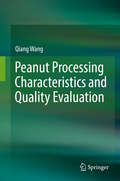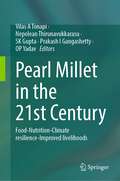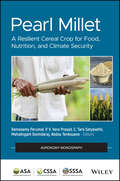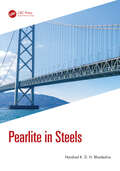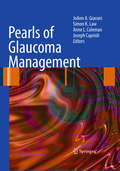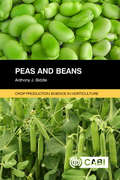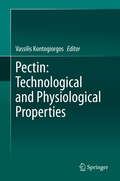- Table View
- List View
Paving Our Ways: A History of the World’s Roads and Pavements
by John Metcalf Max Gordon Lay Kieran SharpPaving Our Ways covers the international history of road paving in an interesting, readable and technically accurate way. It provides an overview of the associated technologies in a historical context. It examines the earliest pavements in Egypt and Mesopotamia and then moves to North Africa, Crete, Greece and Italy, before a review of pavements used by the Romans in their magnificent road system. After its empire collapsed, Roman pavements fell into ruin. The slow recovery of pavements in Europe began in France and then in England. The work of Trésaguet, Telford and McAdam is examined. Asphalt and concrete slowly improved as paving materials in the second part of the 19th century. Major advances occurred in the 20th century with the availability of powerful machinery, pneumatic tyres and bitumen. The advances needed to bring pavements to their current development are explored, as are the tools for financing, constructing, managing and maintaining pavements. The book should appeal to those interested in road paving, and in the history of engineering and transport. It can also serve as a text for courses in engineering history.
Pavlov's Physiology Factory: Experiment, Interpretation, Laboratory Enterprise
by Daniel P. TodesRussian physiologist and Nobel Prize winner Ivan Pavlov is most famous for his development of the concept of the conditional reflex and the classic experiment in which he trained a dog to salivate at the sound of a bell. In Pavlov's Physiology Factory: Experiment, Interpretation, Laboratory Enterprise, Daniel P. Todes explores Pavlov's early work in digestive physiology through the structures and practices of his landmark laboratory—the physiology department of the Imperial Institute for Experimental Medicine. In Lectures on the Work of the Main Digestive Glands, for which Pavlov won the Nobel Prize in 1904, the scientist frequently referred to the experiments of his coworkers and stated that his conclusions reflected "the deed of the entire laboratory." This novel claim caused the prize committee some consternation. Was he alone deserving of the prize? Examining the fascinating content of Pavlov's scientific notes and correspondence, unpublished memoirs, and laboratory publications, Pavlov's Physiology Factory explores the importance of Pavlov's directorship of what the author calls a "physiology factory" and illuminates its relationship to Pavlov's Nobel Prize-winning work and the research on conditional reflexes that followed it.Todes looks at Pavlov's performance in his various roles as laboratory manager, experimentalist, entrepreneur, and scientific visionary. He discusses changes wrought by government and commercial interests in science and sheds light on the pathways of scientific development in Russia—making clear Pavlov's personal achievements while also examining his style of laboratory management. Pavlov's Physiology Factory thus addresses issues of importance to historians of science and scientists today: "big" versus "small" science, the dynamics of experiment and interpretation, and the development of research cultures.
Pax Technica
by Philip N. HowardShould we fear or welcome the internet's evolution? The "internet of things" is the rapidly growing network of everyday objects--eyeglasses, cars, thermostats--made smart with sensors and internet addresses. Soon we will live in a pervasive yet invisible network of everyday objects that communicate with one another. In this original and provocative book, Philip N. Howard envisions a new world order emerging from this great transformation in the technologies around us. Howard calls this new era a Pax Technica. He looks to a future of global stability built upon device networks with immense potential for empowering citizens, making government transparent, and broadening information access. Howard cautions, however, that privacy threats are enormous, as is the potential for social control and political manipulation. Drawing on evidence from around the world, he illustrates how the internet of things can be used to repress and control people. Yet he also demonstrates that if we actively engage with the governments and businesses building the internet of things, we have a chance to build a new kind of internet--and a more open society.
Payment for Environmental Services in Agricultural Landscapes
by David Zilberman Takumi Sakuyama Leslie Lipper Randy StringerIn recent years, development policy has responded to an increasing concern about natural resource degradation by setting up innovative payment for environmental services (PES) programs in developing countries. PES programs use market and institutional incentives in order to meet both environmental and poverty alleviation objectives. However, their optimal design, implications for the rural poor, and how these initiatives integrate into international treaties on global warming and biodiversity loss are still being discussed. This book addresses these issues by scrutinizing analytical tools, providing policy insights and stimulating debate on linkages between poverty alleviation and environmental protection. In particular, it turns attention towards the role of environmental services in agricultural landscapes as they provide a living for many poor in developing countries. It serves as a valuable reference for academics and students in various disciplines, as well as for policy makers and advisors. This book is a co-publication between Springer and the Food and Agriculture Organization of the United Nations.
PbZn 2020: 9th International Symposium on Lead and Zinc Processing (The Minerals, Metals & Materials Series)
by J. Grogan A. Siegmund S. Alam U. Kerney E. ShibataEstablished in 1970, the PbZn symposium series is considered the leading international technical forum for the lead and zinc processing industries. The PbZn 2020 volume addresses all aspects of current processing technologies for primary and secondary lead and zinc, as well as emerging technologies for both metals.
Peace by Design
by Mardelle McCuskey ShepleyWe live in an era in which designers will make an essential and critical contribution to the health and success of humanity. Design can promote healing in healthcare environments, contribute to good mental health, reduce gun violence, and positively impact health and racial equity, all of which contribute to providing a more peaceful world.The primary focus of this book is to inspire young designers, academics, and practitioners to achieve their maximum societal contribution. It also supports experienced designers seeking reaffirmation of their social goals. To provide a foundation, the first chapter discusses the definition of design and design thinking and evidence regarding the direct and indirect contributions of design to peace. The subsequent chapters address peace endeavors at six scales of the physical environment: sustainable and equitable design, landscape architecture, architecture, interior design, industrial design, and graphic design. Additionally, nine short cameos are provided by contributors from various disciplines, who provide their favorite examples of “peace projects.” Peace can be manifested at multiple levels: world-wide, neighborhood and community, familial, or individual, and the various authors discuss portions from this spectrum. They broadly endorse disciplinary entanglements as a means of addressing societal and sustainability challenges and celebrate the impact of collaboration.This book is essential reading for students and practitioners representing all fields of design, including graphic design, industrial design, interior design, architecture, landscape architecture, and urban design.
Peace of Mind in Earthquake Country
by Peter YanevThe geologic, architectural and structural hazards of earthquakes, and how to recognize, avoid or correct them.
Peach (Crop Production Science in Horticulture)
by Maria Luisa Badenes Gregory Reighard Daniele Bassi James Adaskaveg David Ritchie Daniela Giovannini Nikolaos T Papadopoulos Helga Förster Thomas M Gradziel Gemma Echeverria Gregory A Lang B. Anthony B. Blaauw C. Bonghi A. Botton M. Cirilli Luis Cisneros-Zevallos M. Christofi B. Dichio M. F. Drincovich P. Drogoudi S. Foschi K. Gasic I. Iglesias J. C. Melgar P. Milonas I. S. Minas B. Morandi M. Á. Moreno A. L. Nielsen J. Pieper G. Reig S. Sansavini Guido Schnabel P. Tonutti L. Trainotti A. R Vicente C. XiloyannisPeach is a highly valuable temperate fruit crop with significant consumer demand and nutraceutical benefits. This book provides comprehensive and up-to-date coverage on sustainable production processes for peach and nectarine. The latter is a natural mutation of peach that lacks fuzzy skin. It includes fundamental information to help reduce production risks for growers, improve fruit quality, and increase potential market returns, whilst addressing current emerging issues such as climate change and shifting global and regional production practices. Written by an international team of expert authors and highly illustrated in full colour throughout, Peach presents information in an organized and easy-to-follow manner, with content including: Peach tree architecture. Rootstocks. Cultivars. In-field operations (irrigation, fertilization, thinning, harvest) Fruit quality, composition and nutritional benefits. Peach fruit growth, development and ripening physiology. Postharvest technology, including supply chain management protocols. Preharvest and postharvest diseases. Biology and management of insect pests. The peach canning industry. This is an essential resource for students and researchers in horticulture, as well as professionals in pomology including fruit growers, consultants and extension specialists, and cold storage and transportation managers.
Peak Energy: Myth or Reality?
by James G. Speight M. R. IslamDoes the Earth contain enough oil to provide energy for the human race indefinitely? If not, how long will the oil last? What about renewable energy technologies like wind and solar? Will they be able to supply an indefinite supply of energy for the human race? If not, how long will it last? And what role does overpopulation play in our world's energy supply? Even with multiple forms of energy available, how long will it last as long as more and more humans, and therefore more industries and energy consumption, are added? Taking a long-held theory called "Peak Oil Theory" the authors of this groundbreaking new text examine the theory of "Peak Energy" to examine all of these questions. Crude oil and natural gas are the major sources of fuel used to supply energy for various needs. Users of crude oil and natural gas must take into account that these energy sources are, without doubt, non-renewable depleting resources, and the cost of extraction depends not only on the current rate of production but also on the amount of cumulative production. In fact, many pundits believe projections that the world is rapidly apprpaching a precipice, after which crude oil and natural gas will no longer be in ready supply. This phenomenon has given rise to the peak oil theory - peak oil is the point in time when the maximum rate of petroleum recovery from the reservoir is reached, after which the rate of petroleum production enters terminal decline. From this concept has emerged the wider concept of the peak energy theory which, as it is related to the availability of all fossil fuels, is also subject to decline with fossil fuel use. This text, written by two of the world's most well-known, respected, and prolific writers in the energy industry, is a fascinating study of our world's energy needs and the future of the multi-source energy supply on this planet. Whether oil and gas, wind, solar, geothermal, or even nuclear, all sources of energy have their limits, and we, as scientists, engineers, and consumers of energy need to be knowledgeable on these topics. This book is a must-have for any engineer, student, scientist, or even layperson interested in energy and the idea of energy sustainability on planet Earth.
Peak Load And Capacity Pricing
by Chris HarrisPeak Load and Capacity Pricing lays out clear pricing strategies for understanding peak load and capacity pricing structures, further cementing electricity's role as an asset class with fixed and variable costs. This work presents a global recasting of electricity market design, and it will be of direct use to practitioners, academics, commentators, planners, and policy makers in electricity. Harris places electricity firmly in the canon of the microeconomics and econo-engineering of pricesetting, from bridges to other infrastructure assets. His findings and research offer a fresh alternative to prevailing policies and regulations.
Peak Oil: Apocalyptic Environmentalism and Libertarian Political Culture
by Matthew Schneider-MayersonIn recent years, the concept of "peak oil"--the moment when global oil production peaks and a train of economic, social, and political catastrophes accompany its subsequent decline--has captured the imagination of a surprisingly large number of Americans, ordinary citizens as well as scholars, and created a quiet, yet intense underground movement. In Peak Oil, Matthew Schneider-Mayerson takes readers deep inside the world of "peakists," showing how their hopes and fears about the postcarbon future led them to prepare for the social breakdown they foresee--all of which are fervently discussed and debated via websites, online forums, videos, and novels. By exploring the worldview of peakists, and the unexpected way that the fear of peak oil and climate change transformed many members of this left-leaning group into survivalists, Schneider-Mayerson builds a larger analysis of the rise of libertarianism, the role of oil in modern life, the political impact of digital technologies, the racial and gender dynamics of post-apocalyptic fantasies, and the social organization of environmental denial.
Peak Performance: How to Achieve and Sustain Excellence in Operations Management (Sustainable Improvements in Environment Safety and Health)
by Patricia Melton Allen Frances E. Alston Emily Millikin DeKerchoveThe key to success and reaching peak performance is integrating three processes to optimize business through the use of human performance improvement tools, lean thinking, operational excellence, along with a strong organizational culture as the underpinning. These components form the basis of the Peak Performance Model. The tools presented in this book, along with the case studies, demonstrate how the model is applied and integrated into company practices. Companies and organizations want to improve their performance, but many have not integrated the right tools and processes. Through the application of the Peak Performance Model, every company can achieve and sustain Peak Performance.
Peak-to-Peak Output Current Ripple Analysis in Multiphase and Multilevel Inverters
by Jelena LoncarskiThe book introduces an original and effective method for the analysis of peak-to-peak output current ripple amplitude in three-phase two-level inverters. It shows that the method can be extended to both multiphase inverters, with particular emphasis on five-phase and seven-phase inverters, and multilevel ones, with particular emphasis on three-level inverters, and provides, therefore, a comparison among different number of output phases and voltage levels. The work reported on here represents the first detailed analysis of the peak-to-peak output current ripple. It makes an important step toward future developments in the field of high-power generation, and in grid-connected and motor-load systems.
Peaks and Troughs: In at the Deep End, High in the Hills
by Nick PerryA memoir of two brothers using an unexpected inheritance to start an organic farm in 1970 Wales: &“This is Bill Bryson with muck under the fingernails.&” —Brian Morton Londoners Nick Perry and his brother Jack were stuck in a bit of a rut. Nick, in his early twenties with a wife of infant twins, had been jumping from job to job; Jack chauffeured passengers around for their uncle&’s business. Then an aunt they barely remembered, to their complete surprise, left them a tidy sum of money. It didn&’t take long to come up with an idea—buying a plot of farmland in North Wales. Little did they know what a different world they were entering, and what a challenge it would be to find a way to farm that was in harmony with the earth and the animals in their care. The neighbors have little sympathy as Nick deals with the elements and with his nagging self-doubt. But no matter how close to the edge he and his family come, he carries on—and in this war-hearted, humorous, and ultimately inspirational tale, he tells the full story of a young man&’s attempt to run an organic farm in the unforgiving Welsh hills.
Peaks, Spikes, and Barrels: Modeling Sharp Movements in Oil Prices
by Alun Thomas Martin Mühleisen Malika PantA report from the International Monetary Fund.
Peanut Allergy Epidemic
by Janet Levatin Heather Fraser Woody Fraser-BoychuckEssential Reading for Every Parent In the early 1990s, tens of thousands of children with severe peanut and food allergies arrived for kindergarten at schools in Canada, the United Kingdom, Australia, and the United States. The phenomenon of a life-threatening allergy in kids in only these countries occurred simultaneously, without warning, and it quickly intensified. The number of peanut allergic children in the United States alone went from virtually none to about two million in just twenty years. As these children have aged, the combined number of American adults and children allergic to peanuts has grown to a total of four million. How and why has this epidemic occurred? In The Peanut Allergy Epidemic, Heather Fraser explains: Precisely when the peanut allergy epidemic began How a child-specific allergy epidemic happened before, at the close of the nineteenth century That in the early twentieth century doctors including the 1913 Nobel Prize in medicine winner identified vaccination as the cause of the first pediatric allergy epidemic impacting 50 percent of children That more than one hundred years of medical literature describes how vaccination creates allergy to what is in the shot, air, or body at the time of injection How changes in US vaccination legislation sparked the allergy epidemic in children Fraser also highlights alternative medicines and explores issues of vaccine safety and other food allergies, making this fully updated second edition a must-read for every parent, teacher, and health professional.
Peanut Processing Characteristics and Quality Evaluation
by Qiang WangThis book systematically covers the sensory, physical, chemical nutrition, and processing characteristics of different peanut varieties, while also providing an in-depth review of research advances in peanut processing quality. The book goes on to examine the relationship between raw materials and the qualities of peanut protein, peanut oil and other main peanut processing products. As such, it provides a valuable reference guide for research into the raw materials, change mechanisms and control technologies used in peanut processing, laying the groundwork for the development of new disciplines in "grain and oil processing quality". It will be useful for graduate students, researchers, and management groups from multidisciplinary audiences, covering both food science & technology and public health.
Pearl Millet in the 21st Century: Food-Nutrition-Climate resilience-Improved livelihoods
by Vilas A Tonapi Nepolean Thirunavukkarasu Sk Gupta Prakash I Gangashetty Op YadavThis book documents the global pearl millet research for achieving the sustainable development goals in the eve of International Year of Millets in 2023 by FAO. This book offers perspectives on the recent advances in the field of genomics, next-generation breeding approaches, hybrid development, crop production and protection technologies of pearl millets. Pearl millet is the world’s most important millet grown in the hot, semi-arid ecologies of Asia and Africa with versatile end uses. Of all the world’s cereals, pearl millet ranks the sixth most important crop after rice, wheat, maize, barley and sorghum. In the changing climatic condition, it can be pitched as strategic crop for food and nutritional security owing to its ability to survive in harsh ecologies and the higher micro-nutrients grain content. This books focuses on nutritional importance, climate resilience, seed systems, value-addition and market policies to enhance the genetic gain of pearl millets under marginal and favorable ecologies, and way forward for a food and nutrition secure world. It is a useful reading material for researchers and professionals working on small grains, millets and their cultivation and nutrition related aspects.
Pearl Millet: A Resilient Cereal Crop for Food, Nutrition, and Climate Security (Agronomy Monographs)
by Mahalingam Govindaraj Abdou Tenkouano C. Tara Satyavathi Ramasamy Perumal P. V. Vara PrasadIn this age of climate change, discover how pearl millet is considered a viable alternative cereal crop for semi-arid and hot areas Pearl millet, a warm-season, dryland cereal crop, is a staple food for over 90 million people in Africa and Asia. Its nutritional superiority relative to other cereal crops, such as rice, wheat, maize, and sorghum, and its hardiness and adaptability to harsh environments and poor soils make it a potentially life-saving resource for poor populations and/or areas hit by damaging climatic conditions. With climate change Placing an ever-greater strain on global agrifood systems, pearl millet has never been a more important crop in the fight against poverty, hunger, and malnutrition. Pearl Millet offers a thorough introduction to this potentially vital grain. Coming on the heels of a 2023 United Nations declaration of the “International Year of Millets,” it is a crucial intervention in an essential humanitarian project. It is the first comprehensive book on the subject to appear in print. Key Features: Analysis of a potential lead crop for climate-change-affected areasDetailed coverage of all pearl millet’s unique features, such as inherent genetic diversity, gluten free applications, and suitability for double croppingAn author team with vast research and crop development experience Pearl Millet is ideal for advanced undergraduate and graduate students, certified and practicing professionals, as well as industry and academic researchers.
Pearlite in Steels
by Harshad K. BhadeshiaPearlitic steel is the strongest commercially available mass-produced alloy, and pearlite is used in a myriad of applications, from the reinforcement of tyres in every single road vehicle in the world, to the creation of pathways across troubled waters. Pearlite in Steels is the first book dedicated to this vast subject. The book uniquely covers the topic in depth, providing a comprehensive coverage of fundamentals and technologies that make pearlite vital as an engineered material.• Covers the 3D-structure of pearlite over a wide range of length scales.• Details the relationship between imperfect structure and consequences.• Discusses all aspects of structure and complex properties.• Covers the evolution of structure during traumatic processing.• Engineering aspects are highlighted: the twisting of pearlitic wires, for the safe application of the strongest of ropes in safety-critical scenarios.• Highlights difficulties and inconsistencies, thereby helping to develop research.Aimed at materials engineers and metallurgists, this book by a leading global authority on the subject offers readers the deepest and broadest overview of pearlite in steels to date.
Pearls of Glaucoma Management
by Simon K. Law Joann A. Giaconi Joseph Caprioli Anne L. ColemanThis concise and comprehensive guide is written by international experts of the field who are familiar with the world's literature. Based on the world's literature and their own experience, authors state and explain how they prefer to manage patients and problems clinically. Each chapter author gives the reader numerous clear and specific tips and pearls for the diagnosis and management of Glaucoma. The reader-friendly structure of this lavishly illustrated 4-colour book ensures that the necessary information is quickly found and remembered. This book ensures a pleasant learning experience on Glaucoma management with the goal of an improved treatment outcome.
Peas and Beans
by Anthony J. BiddleThis practical book provides an accessible overview of all aspects of pea and bean production, including botany and physiology, breeding, agronomy, weed management, pests and diseases, harvesting, nutritional value and uses. It also reflects on the constraints and opportunities in the future for peas and beans, exploring their role in food sustainability and crop rotation, and various factors affecting supply and demand such as climate change and breeding technologies. Peas and beans are crops of economic, social and agronomic importance and this volume provides the specialist knowledge needed to ensure good quality standards are met. It includes: #65533; coverage of the main types of peas and beans grown on a significant scale or commercially produced in large area farming; #65533; key information relating to the role of peas and beans in biological nitrogen fixation; #65533; extensive coverage from the technology of cultivation to postharvest industry; and #65533; high-quality photos, presented in full colour throughout. Authored by a recognized authority with extensive experience in applied research, this book is an ideal resource for practical agronomists, advisors and producers, extension workers, horticulture students and all those involved in the production of peas and beans.
Peas and Beans: A Color Handbook (Crop Production Science in Horticulture)
by Anthony J BiddleThis practical book provides an accessible overview of all aspects of pea and bean production, including botany and physiology, breeding, agronomy, weed management, pests and diseases, harvesting, nutritional value and uses. It also reflects on the constraints and opportunities in the future for peas and beans, exploring their role in food sustainability and crop rotation, and various factors affecting supply and demand such as climate change and breeding technologies. Peas and beans are crops of economic, social and agronomic importance and this volume provides the specialist knowledge needed to ensure good quality standards are met. It includes: · coverage of the main types of peas and beans grown on a significant scale or commercially produced in large area farming; · key information relating to the role of peas and beans in biological nitrogen fixation; · extensive coverage from the technology of cultivation to postharvest industry; and · high-quality photos, presented in full colour throughout. Authored by a recognized authority with extensive experience in applied research, this book is an ideal resource for practical agronomists, advisors and producers, extension workers, horticulture students and all those involved in the production of peas and beans.
Peatland Biogeochemistry and Watershed Hydrology at the Marcell Experimental Forest
by Kenneth N. Brooks Randall K. Kolka Stephen D. Sebestyen Elon S. VerryThe Marcell Experimental Forest (MEF) in Minnesota serves as a living laboratory and provides scientists with a fundamental understanding of peatland hydrology, acid rain impacts, nutrient and carbon cycling, trace gas emissions, and controls on mercury transport in boreal watersheds. Its important role in scientific research continues to grow as t
Pectin: Technological and Physiological Properties
by Vassilis KontogiorgosThis text presents the technological and physiological properties of pectin in an educational approach that encompasses all of the essential information a researcher needs to fully understand their function and use in foods. Utilizing basic information on pectin as well as recent technological advances, this book is designed to be the primary resource for individuals seeking out an up to date reference work covering all the necessary informational and functional aspects of pectin. Pectin: technological and physiological properties is the first book to fully focus on the introductory concepts on pectin. Individual chapters cover localization and function, the structural aspects of pectin, pectinases, isolation and characterization and recovery from agricultural wastes. Important current advances such as emulsions, films, digestion, metabolism and bioactive properties are also focused on. With its combination of vital basic information and technological advances, this book presents full and up to date coverage on this pectin and its many forms and uses in foods.
